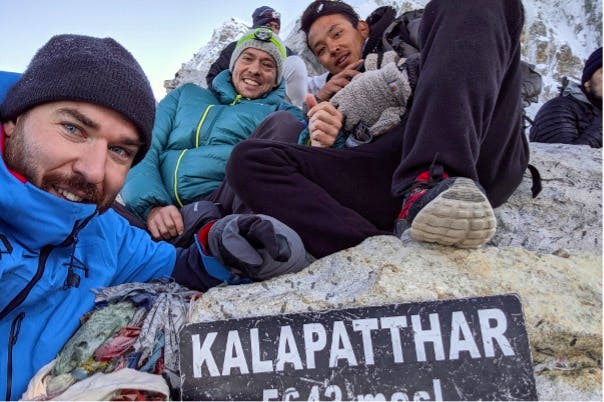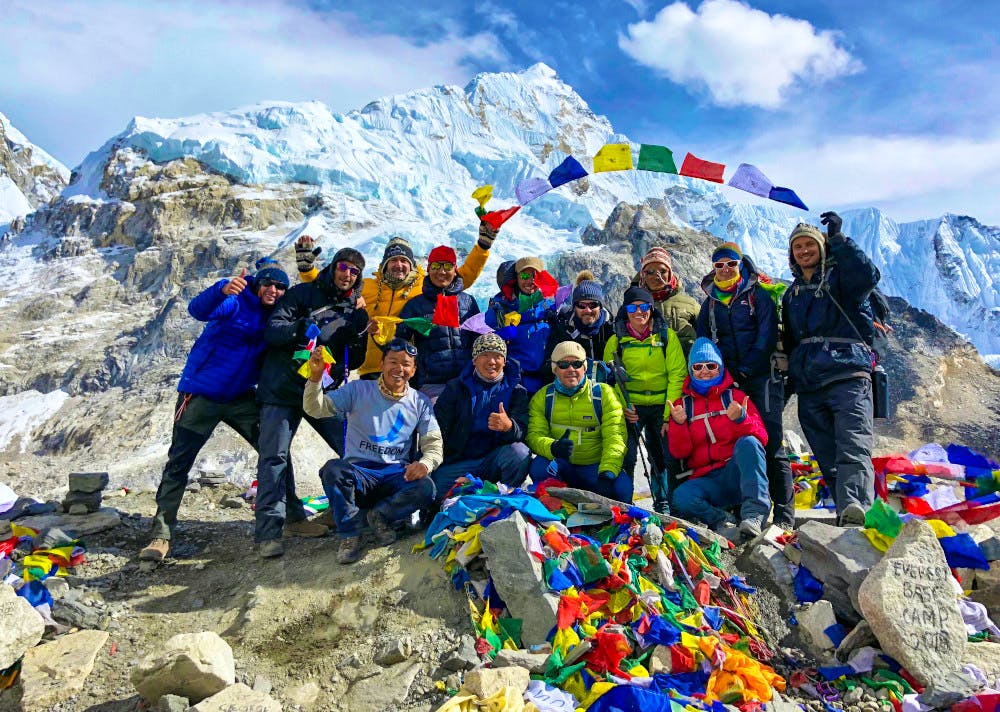30 Everest Base Camp Trekking Tips For A Successful Adventure
Embarking on an EBC hike is the adventure of a lifetime. But like any epic journey, it comes with its set of challenges. We've compiled these essential Everest Base Camp trekking tips to help you conquer Base Camp like a champion.
Our Top 30 Everest Base Camp Trekking Tips
Whether you're a seasoned trekker or a first-timer, our top 30 Everest Base Camp trekking tips are designed to help you.
Let's jump in.
1. Importance of Acclimatisation: How to Manage Altitude Sickness.
Acclimatisation is not just a buzzword; it's a necessity when trekking to Everest Base Camp. The higher you go, the thinner the air becomes, increasing the risk of Everest Base Camp altitude sickness.
To manage this, schedule acclimatisation days into your itinerary and consider taking medications like Diamox as a preventive measure. Always consult with your doctor before taking any new medication.

2. Choosing the Right Route: Classic vs. Alternative Routes
The classic route to Everest Base Camp is tried and true, but alternative routes like the Gokyo Lakes trek offer a different experience.
Weigh the pros and cons of each, considering factors like scenery, difficulty, and crowd levels, to pick the route that aligns with your trekking goals.
3. Importance of Physical Preparation: Training Routines and Fitness
You don't need to be an Olympic athlete, but a solid fitness level is crucial for a successful trek.
Incorporate cardio, strength training, and altitude-specific workouts into your training plan for Everest Base Camp at least three months before your trek. The fitter you are, the more you'll enjoy the journey.
4. Planning Extra Days: Accounting for Weather and Flight Delays
The Himalayas are notorious for unpredictable Everest Base Camp weather, and flight delays are common.
Always plan a few extra days into your itinerary to account for any unforeseen hiccups. This buffer will reduce stress and give you a better chance of reaching Base Camp.

5. Foot Care: Preventing and Treating Blisters
Your feet are your most valuable asset on the trek, so take good care of them.
Invest in quality trekking boots, and break them in well before your journey. Always carry blister treatment kits and know some foot care basics to prevent and treat blisters effectively.
6. Flight Deals: How to Get the Best Prices on Flights to Nepal
Scoring a great deal on your flight to Nepal can significantly impact your trekking budget.
Consider booking your flight several months in advance and use fare comparison websites, like Google Flights, to find the best deals. Remember to set fare alerts for price drops!
7. Gear Shopping in Kathmandu: Finding Quality Gear at Affordable Prices
Kathmandu is a treasure trove for trekking gear. You'll find quality equipment from branded stores to local shops without breaking the bank. Just make sure to double-check the quality and try on gear before purchasing.

8. Snack Strategy: Carrying Your Own to Save on Mountain Prices
While trekking, you'll find that snacks at higher altitudes come with inflated prices.
Save money by packing your own high-energy snacks like trail mix, protein bars, and dried fruits. Not only will you save money, but you'll also have your favourite snacks on hand.
9. Booking in Advance: How Early Booking Can Save Money
Whether it's flights, accommodations, or Everest Base Camp trekking packages, booking in advance often comes with discounts.
Plan your trek several months ahead and take advantage of early-bird rates to make your adventure more affordable.
10. Group Discounts: The More, The Merrier, and Cheaper
Travelling with a group can often lead to discounts on various aspects of the trek, from guided tours to accommodation. Many trekking companies offer group discounts, so gather your adventurous friends and family to save some cash without compromising on safety or experience.
11. Hydration: Importance of Staying Hydrated and Water Purification Tips
Staying hydrated is crucial, especially at high altitudes. Always carry a reusable water bottle and consider using water purification tablets or a portable filter. Dehydration can exacerbate the symptoms of altitude sickness, so make hydration a priority.

12. Local Cuisine: Foods to Try and Foods to Avoid
Nepal offers a variety of delicious local dishes like dal bhat and momo. While trying everything is tempting, be cautious with street food, meat and water-based dishes to avoid stomach issues. Stick to reputable restaurants and teahouses for your culinary adventures.
13. Snack Essentials: What to Pack for Quick Energy Boosts
For those moments when you need a quick pick-me-up, pack high-energy snacks like nuts, dried fruits, and energy bars. These are tasty and provide the essential nutrients and calories you'll need on the trail.
14. Tea Houses: What to Expect and Food Options
EBC tea houses are a staple on the trek, offering both accommodation and meals. Expect basic but hearty dishes like dal bhat, noodles, and soups. Sticking to vegetarian options is an excellent idea to minimise the risk of food borne illnesses.

Latest Deals
15. Dietary Restrictions: How to Navigate Food Choices If You Have Restrictions
If you have dietary restrictions, communication is critical. Most teahouses can accommodate vegetarian, vegan, and gluten-free diets. Always inform your guide or the teahouse owner in advance to ensure your needs are met.
16. Luggage Weight Limits: Guidelines on How Much to Pack
When it comes to packing for Everest Base Camp, less is more. Most airlines have strict weight limits for flights to Lukla, and porters can only carry a limited amount. Aim for a total weight of around 10-15 kg, including your daypack.
17. Essential Gear: Must-Have Items for the Trek
Don't leave home without the essentials: a good pair of trekking boots, a down jacket, and a quality 4-season sleeping bag must be on your Everest Base Camp packing list. These items are non-negotiable and will make or break your trekking experience.

18. Clothing Layers: What to Wear at Different Altitudes
Layering is the key to staying comfortable on the trek. Opt for moisture-wicking base layers, insulating mid-layers, and waterproof outer layers. You can add or remove layers to regulate your body temperature as you ascend.
See more on EBC trek clothing.
19. Personal Hygiene: What to Bring for Cleanliness and Sanitation
Maintaining good hygiene on the trail is crucial. Pack travel-sized toiletries like toothpaste, soap, toilet paper and wet wipes. Hand sanitisers are a must, especially before meals. Ladies, consider packing a urination device and menstrual cup for convenience and sustainability.
20. Tech Gear: Recommendations for Cameras, Power Banks, Etc.
Capturing the beauty of the Himalayas is a must, so bring a good camera or smartphone with a reliable battery. A power bank is essential for keeping your devices charged, especially in higher altitudes where electricity is scarce.
21. Best Time to Trek: Ideal Seasons and What to Expect
The best time to trek Everest Base Camp are pre-monsoon (March to May) and post-monsoon (September to November). These seasons offer relatively stable weather, clear skies, and moderate temperatures, making for an ideal trekking experience.

22. Preparing for Cold: How to Stay Warm in Freezing Temperatures
Temperatures can plummet, especially at night and at higher altitudes. Thermal underwear, down jackets, and quality sleeping bags are essential. Hand and foot warmers can also be a lifesaver when the mercury drops.
23. Rainy Season: What to Expect and How to Prepare
Trekking during the monsoon season (June to August) is not recommended due to heavy rains, landslides, and poor visibility. Always consider your safety and only trek during suitable seasons.
24. Sun Protection: Importance of Sunscreen, Hats, and Sunglasses
The sun can be surprisingly intense in the mountains. Always apply a high-SPF sunscreen, wear a wide-brimmed hat, and use UV-protective sunglasses to shield yourself from harmful rays.
25. Wind and Dust: How to Protect Yourself from the Elements
Wind and dust can be relentless, especially in the barren landscapes closer to Base Camp. A good quality buff or scarf and a pair of wrap-around sunglasses can offer much-needed protection.

26. First Aid Kit: What to Include for Minor Injuries and Ailments
A well-stocked first aid kit is a trekking essential. Include basics like band-aids, antiseptic wipes, pain relievers, and specialised items like blister treatment.
27. Travel Insurance: Why It's Essential and What It Should Cover
Don't even think about trekking to Everest Base Camp without comprehensive travel insurance. Ensure your EBC hiking insurance policy covers high-altitude trekking, emergency evacuation, and medical treatment in remote areas.
28. Emergency Contacts: Keeping a List and Knowing How to Reach Help
Always keep a list of emergency contacts, including local authorities and your country's embassy. Ensure your guide and trekking company also have these details and know the nearest locations for medical help.
29. Mental Preparedness: Tips for Staying Positive and Focused
The trek is as much a mental challenge as a physical one. Prepare yourself mentally by setting realistic expectations and practising mindfulness techniques to stay positive and focused during the trek.
30. Sleep and Rest: Importance of Good Sleep and Rest Days
Quality sleep and rest days are crucial for your body to recover and acclimatise. Make sure to get at least 7-8 hours of sleep each night and utilise rest days to recharge physically and mentally.
More EBC Articles
Popular EBC Trips
Find your next adventure
Why Skyhook?
Join over 27,000 Skyhook adventurers who've used our platform to book directly with our vetted local guides, at local prices (we never markup).
Expert Local Guides
Experienced local guides, handpicked by us.
Best Prices
Never pay a markup on the local guide's price.
Exclusive Club
Earn loyalty rewards every time you travel.
Great Social Vibes
Small group tours provide a richer experience.
Stellar Feedback
Over 2,800 reviews, average of 4.9/5 stars.












